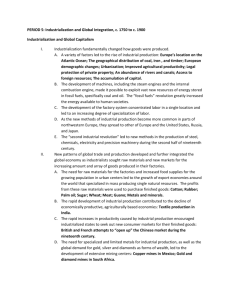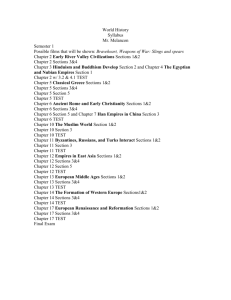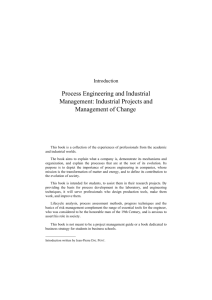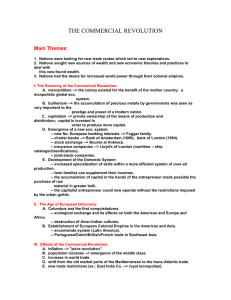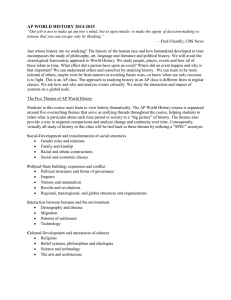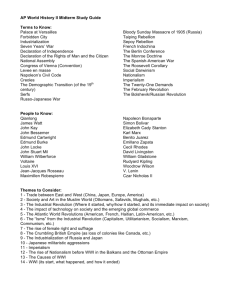–1914 COLLEGE BOARD OUTLINE 1750
advertisement
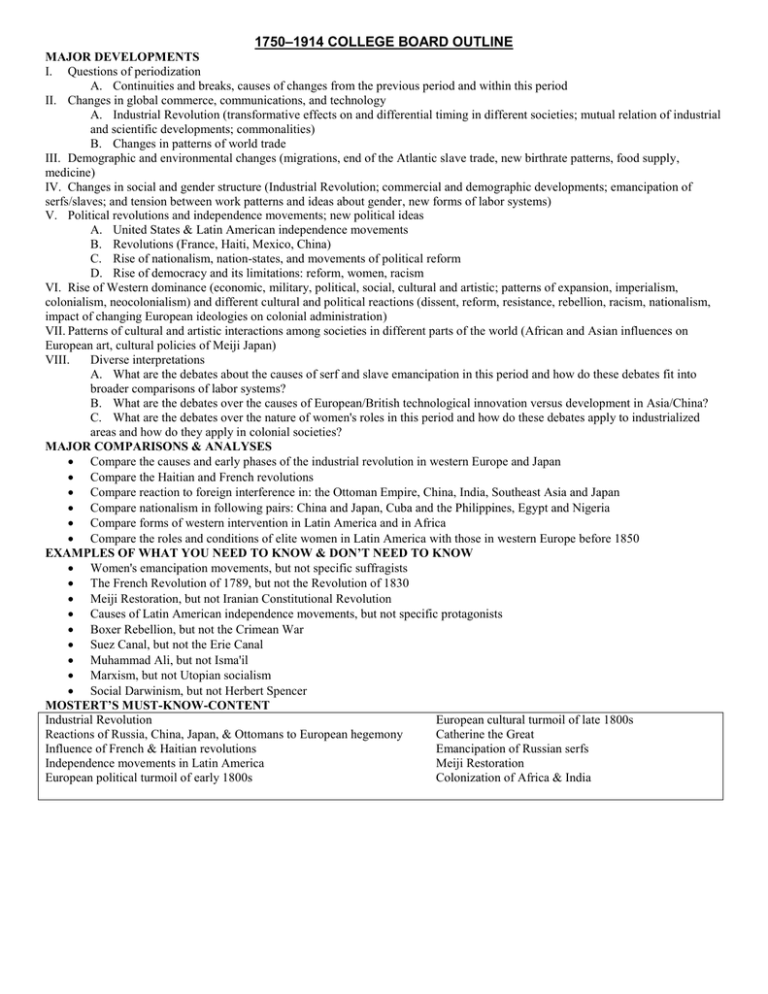
1750–1914 COLLEGE BOARD OUTLINE MAJOR DEVELOPMENTS I. Questions of periodization A. Continuities and breaks, causes of changes from the previous period and within this period II. Changes in global commerce, communications, and technology A. Industrial Revolution (transformative effects on and differential timing in different societies; mutual relation of industrial and scientific developments; commonalities) B. Changes in patterns of world trade III. Demographic and environmental changes (migrations, end of the Atlantic slave trade, new birthrate patterns, food supply, medicine) IV. Changes in social and gender structure (Industrial Revolution; commercial and demographic developments; emancipation of serfs/slaves; and tension between work patterns and ideas about gender, new forms of labor systems) V. Political revolutions and independence movements; new political ideas A. United States & Latin American independence movements B. Revolutions (France, Haiti, Mexico, China) C. Rise of nationalism, nation-states, and movements of political reform D. Rise of democracy and its limitations: reform, women, racism VI. Rise of Western dominance (economic, military, political, social, cultural and artistic; patterns of expansion, imperialism, colonialism, neocolonialism) and different cultural and political reactions (dissent, reform, resistance, rebellion, racism, nationalism, impact of changing European ideologies on colonial administration) VII. Patterns of cultural and artistic interactions among societies in different parts of the world (African and Asian influences on European art, cultural policies of Meiji Japan) VIII. Diverse interpretations A. What are the debates about the causes of serf and slave emancipation in this period and how do these debates fit into broader comparisons of labor systems? B. What are the debates over the causes of European/British technological innovation versus development in Asia/China? C. What are the debates over the nature of women's roles in this period and how do these debates apply to industrialized areas and how do they apply in colonial societies? MAJOR COMPARISONS & ANALYSES Compare the causes and early phases of the industrial revolution in western Europe and Japan Compare the Haitian and French revolutions Compare reaction to foreign interference in: the Ottoman Empire, China, India, Southeast Asia and Japan Compare nationalism in following pairs: China and Japan, Cuba and the Philippines, Egypt and Nigeria Compare forms of western intervention in Latin America and in Africa Compare the roles and conditions of elite women in Latin America with those in western Europe before 1850 EXAMPLES OF WHAT YOU NEED TO KNOW & DON’T NEED TO KNOW Women's emancipation movements, but not specific suffragists The French Revolution of 1789, but not the Revolution of 1830 Meiji Restoration, but not Iranian Constitutional Revolution Causes of Latin American independence movements, but not specific protagonists Boxer Rebellion, but not the Crimean War Suez Canal, but not the Erie Canal Muhammad Ali, but not Isma'il Marxism, but not Utopian socialism Social Darwinism, but not Herbert Spencer MOSTERT’S MUST-KNOW-CONTENT Industrial Revolution European cultural turmoil of late 1800s Reactions of Russia, China, Japan, & Ottomans to European hegemony Catherine the Great Influence of French & Haitian revolutions Emancipation of Russian serfs Independence movements in Latin America Meiji Restoration European political turmoil of early 1800s Colonization of Africa & India ERA OF WESTERN HEGEMONY INDUSTRIALIZATION AND GLOBAL INTEGRATION, C. 1750 TO C. 1900 Mostert’s Must-Know Content: Industrial Revolution Second Industrial Revolution Reactions of Russia, China, Japan, & Ottomans to European hegemony Influence of French & Haitian revolutions Independence movements in Latin America European political turmoil of early 1800s European cultural turmoil of late 1800s Catherine the Great Emancipation of Russian serfs Meiji Restoration Colonization of Africa & India College Board Must Know Content: Key Concept 5.1. Industrialization and Global Capitalism Industrialization fundamentally altered the production of goods around the world. It not only changed how goods were produced and consumed, as well as what was considered a “good,” but it also had far-reaching effects on the global economy, social relations, and culture. Although it is common to speak of an “Industrial Revolution,” the process of industrialization was a gradual one that unfolded over the course of the eighteenth and nineteenth centuries, eventually becoming global. Industrialization fundamentally changed how goods were produced. A variety of factors led to the rise of industrial production. The development of machines, including steam engines and the internal combustion engine, made it possible to exploit vast new resources of energy stored in fossil fuels, specifically coal and oil. The “fossil fuels” revolution greatly increased the energy available to human societies. The development of the factory system concentrated labor in a single location and led to an increasing degree of specialization of labor. As the new methods of industrial production became more common in parts of northwestern Europe, they spread to other parts of Europe and the United States, Russia, and Japan. The “second industrial revolution” led to new methods in the production of steel, chemicals, electricity and precision machinery during the second half of the nineteenth century. New patterns of global trade and production developed and further integrated the global economy as industrialists sought raw materials and new markets for the increasing amount and array of goods produced in their factories. The need for raw materials for the factories and increased food supplies for the growing population in urban centers led to the growth of export economies around the world that specialized in mass producing single natural resources. The profits from these raw materials were used to purchase finished goods. The rapid development of industrial production contributed to the decline of economically productive, agriculturally based economies. The rapid increases in productivity caused by industrial production encouraged industrialized states to seek out new consumer markets for their finished goods. The need for specialized and limited metals for industrial production, as well as the global demand for gold, silver and diamonds as forms of wealth, led to the development of extensive mining centers. To facilitate investments at all levels of industrial production, financiers developed and expanded various financial institutions. The ideological inspiration for economic changes lies in the development of capitalism and classical liberalism associated with Adam Smith and John Stuart Mill. Financial instruments expanded. The global nature of trade and production contributed to the proliferation of large-scale transnational businesses. There were major developments in transportation and communication. The development and spread of global capitalism led to a variety of responses. In industrialized states, many workers organized themselves to improve working conditions, limit hours, and gain higher wages, while others opposed capitalist exploitation of workers by promoting alternative visions of society. In Qing China and the Ottoman Empire, some members of the government resisted economic change and attempted to maintain preindustrial forms of economic production. In a small number of states, governments promoted their own state-sponsored visions of industrialization. In response to criticisms of industrial global capitalism, some governments mitigated the negative effects of industrial capitalism by promoting various types of reforms. The ways in which people organized themselves into societies also underwent significant transformations in industrialized states due to the fundamental restructuring of the global economy. New social classes, including the middle class and the industrial working class, developed. Family dynamics, gender roles, and demographics changed in response to industrialization. Rapid urbanization that accompanied global capitalism often led to unsanitary conditions, as well as to new forms of community. Key Concept 5.2. Imperialism and Nation-State Formation As states industrialized during this period, they also expanded their existing overseas colonies and established new types of colonies and transoceanic empires. Regional warfare and diplomacy both resulted in and were affected by this process of modern empire building. The process was led mostly by Europe, although not all states were affected equally, which led to an increase of European influence around the world. The United States and Japan also participated in this process. The growth of new empires challenged the power of existing land-based empires of Eurasia. New ideas about nationalism, race, gender, class, and culture also developed that facilitated the spread of transoceanic empires, as well as justified anti-imperial resistance and the formation of new national identities. Industrializing powers established transoceanic empires. States with existing colonies strengthened their control over those colonies. European states, as well as the Americans and the Japanese, established empires throughout Asia and the Pacific, while Spanish and Portuguese influence declined. Many European states used both warfare and diplomacy to establish empires in Africa. In some parts of their empires, Europeans established settler colonies. In other parts of the world, industrialized states practiced economic imperialism. Imperialism influenced state formation and contraction around the world. The expansion of U.S. and European influence over Tokugawa Japan led to the emergence of Meiji Japan. The United States and Russia emulated European transoceanic imperialism by expanding their land borders and conquering neighboring territories. Anti-imperial resistance led to the contraction of the Ottoman Empire. New states developed on the edges of existing empires. The development and spread of nationalism as an ideology fostered new communal identities. New racial ideologies, especially Social Darwinism, facilitated and justified imperialism. Key Concept 5.3. Nationalism, Revolution, and Reform The eighteenth century marked the beginning of an intense period of revolution and rebellion against existing governments, and the establishment of new nation-states around the world. Enlightenment thought and the resistance of colonized peoples to imperial centers shaped this revolutionary activity. These rebellions sometimes resulted in the formation of new states and stimulated the development of new ideologies. These new ideas in turn further stimulated the revolutionary and anti-imperial tendencies of this period. The rise and diffusion of Enlightenment thought that questioned established traditions in all areas of life often preceded the revolutions and rebellions against existing governments. Thinkers applied new ways of understanding the natural world to human relationships, encouraging observation and inference in all spheres of life. Intellectuals critiqued the role that religion played in public life, insisting on the importance of reason as opposed to revelation. Enlightenment thinkers developed new political ideas about the individual, natural rights, and the social contract. The ideas of Enlightenment thinkers influenced resistance to existing political authority, as reflected in revolutionary documents. These ideas influenced many people to challenge existing notions of social relations, which led to the expansion of rights as seen in expanded suffrage, the abolition of slavery and the end of serfdom, as their ideas were implemented. Beginning in the eighteenth century, peoples around the world developed a new sense of commonality based on language, religion, social customs and territory. These newly imagined national communities linked this identity with the borders of the state, while governments used this idea to unite diverse populations. Increasing discontent with imperial rule propelled reformist and revolutionary movements. Subjects challenged the centralized imperial governments. American colonial subjects led a series of rebellions, which facilitated the emergence of independent states in the United States, Haiti, and mainland Latin America. French subjects rebelled against their monarchy. Slave resistance challenged existing authorities in the Americas. Increasing questions about political authority and growing nationalism contributed to anticolonial movements. Some of the rebellions were influenced by religious ideas and millenarianism. Responses to increasingly frequent rebellions led to reforms in imperial policies. The global spread of European political and social thought and the increasing number of rebellions stimulated new transnational ideologies and solidarities. Discontent with monarchist and imperial rule encouraged the development of political ideologies, including liberalism, socialism, and communism. Demands for women’s suffrage and an emergent feminism challenged political and gender hierarchies. Key Concept 5.4. Global Migration Migration patterns changed dramatically throughout this period, and the numbers of migrants increased significantly. These changes were closely connected to the development of transoceanic empires and a global capitalist economy. In some cases, people benefited economically from migration, while other people were seen simply as commodities to be transported. In both cases, migration produced dramatically different societies for both sending and receiving societies, and presented challenges to governments in fostering national identities and regulating the flow of people. Migration in many cases was influenced by changes in demography in both industrialized and unindustrialized societies that presented challenges to existing patterns of living. Changes in food production and improved medical conditions contributed to a significant global rise in population. Because of the nature of the new modes of transportation, both internal and external migrants increasingly relocated to cities. This pattern contributed to the significant global urbanization of the nineteenth century. Migrants relocated for a variety of reasons. Many individuals chose freely to relocate, often in search of work. The new global capitalist economy continued to rely on coerced and semicoerced labor migration. While many migrants permanently relocated, a significant number of temporary and seasonal migrants returned to their home societies. The large-scale nature of migration, especially in the nineteenth century, produced a variety of consequences and reactions to the increasingly diverse societies on the part of migrants and the existing populations. Due to the physical nature of the labor in demand, migrants tended to be male, leaving women to take on new roles in the home society that had been formerly occupied by men. Migrants often created ethnic enclaves in different parts of the world which helped transplant their culture into new environments and facilitated the development of migrant support networks. Receiving societies did not always embrace immigrants, as seen in the various degrees of ethnic and racial prejudice and the ways states attempted to regulate the increased flow of people across their borders.
